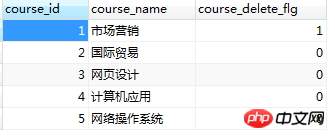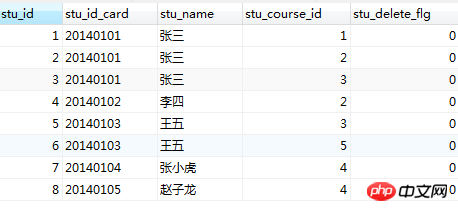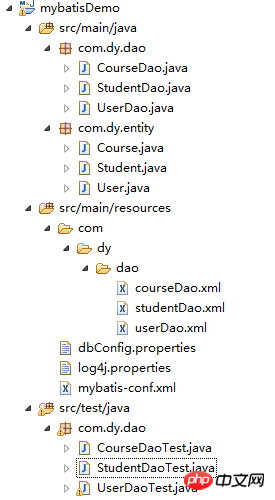 Java
Java
 javaTutorial
javaTutorial
 An in-depth explanation of the Mybatis series (8)---select and resultMap of mapper mapping file configuration
An in-depth explanation of the Mybatis series (8)---select and resultMap of mapper mapping file configuration
An in-depth explanation of the Mybatis series (8)---select and resultMap of mapper mapping file configuration
The previous article "Mybatis series in simple terms (7)---mapper mapping file configuration insert, update, delete" introduced the usage of insert, update, and delete. This article will introduce the usage of select and resultMap. Select is undoubtedly our most commonly used and most complex one. Mybatis can help us perform advanced mapping well through resultMap. Let’s start looking at the options And the usage of resultMap:
Let’s look at the configuration of select first:
<select <!-- 1. id (必须配置)
id是命名空间中的唯一标识符,可被用来代表这条语句。
一个命名空间(namespace) 对应一个dao接口,
这个id也应该对应dao里面的某个方法(相当于方法的实现),因此id 应该与方法名一致 -->
id="selectPerson"
<!-- 2. parameterType (可选配置, 默认为mybatis自动选择处理)
将要传入语句的参数的完全限定类名或别名, 如果不配置,mybatis会通过ParameterHandler 根据参数类型默认选择合适的typeHandler进行处理
parameterType 主要指定参数类型,可以是int, short, long, string等类型,也可以是复杂类型(如对象) -->
parameterType="int"
<!-- 3. resultType (resultType 与 resultMap 二选一配置)
resultType用以指定返回类型,指定的类型可以是基本类型,可以是java容器,也可以是javabean -->
resultType="hashmap"
<!-- 4. resultMap (resultType 与 resultMap 二选一配置)
resultMap用于引用我们通过 resultMap标签定义的映射类型,这也是mybatis组件高级复杂映射的关键 -->
resultMap="personResultMap"
<!-- 5. flushCache (可选配置)
将其设置为 true,任何时候只要语句被调用,都会导致本地缓存和二级缓存都会被清空,默认值:false -->
flushCache="false"
<!-- 6. useCache (可选配置)
将其设置为 true,将会导致本条语句的结果被二级缓存,默认值:对 select 元素为 true -->
useCache="true"
<!-- 7. timeout (可选配置)
这个设置是在抛出异常之前,驱动程序等待数据库返回请求结果的秒数。默认值为 unset(依赖驱动)-->
timeout="10000"
<!-- 8. fetchSize (可选配置)
这是尝试影响驱动程序每次批量返回的结果行数和这个设置值相等。默认值为 unset(依赖驱动)-->
fetchSize="256"
<!-- 9. statementType (可选配置)
STATEMENT,PREPARED 或 CALLABLE 的一个。这会让 MyBatis 分别使用 Statement,PreparedStatement 或 CallableStatement,默认值:PREPARED-->
statementType="PREPARED"
<!-- 10. resultSetType (可选配置)
FORWARD_ONLY,SCROLL_SENSITIVE 或 SCROLL_INSENSITIVE 中的一个,默认值为 unset (依赖驱动)-->
resultSetType="FORWARD_ONLY">There always seem to be so many configurations, but the actual commonly used configurations There are only a few, depending on your own needs. It has been noted above whether they must be configured.
Let’s practice using the previous demo in time:
--------------------------- --------------------------------------------------The following is a practice for select demo------------------------------------------------- -----------------------------------------------
Database: Two new files are added Table (t_course, t_student)
t_course:

t_student:

Among them, 1 Students can choose multiple courses to study.
Let’s take the demo from the previous article and continue writing:
After adding, the project directory will look like this:

Course.java:
package com.dy.entity;public class Course { private int id; private String name;
private int deleteFlag;
public int getId() { return id;
} public void setId(int id) { this.id = id;
} public String getName() { return name;
} public void setName(String name) { this.name = name;
} public int getDeleteFlag() { return deleteFlag;
} public void setDeleteFlag(int deleteFlag) { this.deleteFlag = deleteFlag;
}
}Student.java:
package com.dy.entity;
import java.util.List;public class Student {
private int id;
private String idCard;
private String name;
private List<Course> courseList;
private int deleteFlag;
public Student(int id, String idCard, String name, List<Course> courseList, int deleteFlag) {
this.id = id;
this.idCard = idCard;
this.name = name;
this.courseList = courseList;
this.deleteFlag = deleteFlag;
}
public int getId() { return id;
} public void setId(int id) { this.id = id;
} public String getIdCard() { return idCard;
} public void setIdCard(String idCard) { this.idCard = idCard;
} public String getName() { return name;
} public void setName(String name) { this.name = name;
} public List<Course> getCourseList() { return courseList;
} public void setCourseList(List<Course> courseList) { this.courseList = courseList;
} public int getDeleteFlag() { return deleteFlag;
} public void setDeleteFlag(int deleteFlag) { this.deleteFlag = deleteFlag;
}
}CourseDao.java:
package com.dy.dao;import com.dy.entity.Course;public interface CourseDao {
public Course findCourseById(int courseId);
}StudentDao.java:
package com.dy.dao;import com.dy.entity.Student;public interface StudentDao {
public Student findStudentById(String idCard);
}courseDao.xml:
<mapper namespace="com.dy.dao.CourseDao">
<!--
1.此处直接将resultType 设置为course, 一看就知道我设置了别名吧,如果没有设置别名,那么resultType = com.dy.entity.Course。
2.可能细心的你会发现:Course.java中的属性名与数据库字段名不一致,下面,我就在sql语句中用了as, 使之匹配,当然方法不止一种,
在学习了resultMap之后,你能看到一种更直观优雅的方式去将javabean中的属性与数据库字段名保持一致
3.findCourseById 与CourseDao中findCourseById方法对应, 那么传入的参数名称以及类型也应该保持对应关系。
4.可以看到,在sql语句中,通过#{}表达式可以获取参数。
5.下面这条sql语句,实际上的形式是怎么样的?还记得之前说过,mybatis默认为preparedStatement吧,那么,用我们jdbc代码来看,它其实就是:
select course_id as id, course_name as name, course_delete_flg as deleteFlag from t_course where course_id=? -->
<select id="findCourseById" resultType="course" >
select course_id as id, course_name as name, course_delete_flg as deleteFlag from t_course where course_id=#{courseId} </select>
</mapper>CourseDaoTest.java:
package com.dy.dao;
import java.io.IOException;import org.apache.ibatis.io.Resources;
import org.apache.ibatis.session.SqlSession;
import org.apache.ibatis.session.SqlSessionFactory;
import org.apache.ibatis.session.SqlSessionFactoryBuilder;import org.junit.Test;
import com.dy.entity.Course;public class CourseDaoTest {
@Test public void findCourseById() {
SqlSessionFactory sqlSessionFactory = getSessionFactory();
SqlSession sqlSession = sqlSessionFactory.openSession();
CourseDao courseDao = sqlSession.getMapper(CourseDao.class);
Course course = courseDao.findCourseById(1);
}
//Mybatis 通过SqlSessionFactory获取SqlSession, 然后才能通过SqlSession与数据库进行交互
private static SqlSessionFactory getSessionFactory() {
SqlSessionFactory sessionFactory = null;
String resource = "mybatis-conf.xml";
try {
sessionFactory = new SqlSessionFactoryBuilder().build(Resources
.getResourceAsReader(resource));
} catch (IOException e) {
e.printStackTrace();
}
return sessionFactory;
}
}In the above example, we briefly demonstrated the use of select for course, but there is a question worth thinking about: A student can correspond to multiple courses, so how to deal with this pair in mybatis What about many, or even many-to-many, one-to-one relationships?
Here, we have to mention resultMap. The resultMap function of mybatis is very powerful and can handle complex relationship mapping. So how to configure resultMap? Don’t worry, here it comes:
resultMap的配置:
<!--
1.type 对应类型,可以是javabean, 也可以是其它
2.id 必须唯一, 用于标示这个resultMap的唯一性,在使用resultMap的时候,就是通过id指定 -->
<resultMap type="" id="">
<!-- id, 唯一性,注意啦,这个id用于标示这个javabean对象的唯一性, 不一定会是数据库的主键(不要把它理解为数据库对应表的主键)
property属性对应javabean的属性名,column对应数据库表的列名
(这样,当javabean的属性与数据库对应表的列名不一致的时候,就能通过指定这个保持正常映射了) -->
<id property="" column=""/>
<!-- result与id相比, 对应普通属性 -->
<result property="" column=""/>
<!--
constructor对应javabean中的构造方法 -->
<constructor>
<!-- idArg 对应构造方法中的id参数 -->
<idArg column=""/>
<!-- arg 对应构造方法中的普通参数 -->
<arg column=""/>
</constructor>
<!--
collection,对应javabean中容器类型, 是实现一对多的关键
property 为javabean中容器对应字段名
column 为体现在数据库中列名
ofType 就是指定javabean中容器指定的类型 -->
<collection property="" column="" ofType=""></collection>
<!--
association 为关联关系,是实现N对一的关键。
property 为javabean中容器对应字段名
column 为体现在数据库中列名
javaType 指定关联的类型 -->
<association property="" column="" javaType=""></association>
</resultMap>好啦,知道resutMap怎么配置后,咱们立即接着上面的demo来练习一下吧:
------------------------------------------------------------------下面是用resultMap处理一对多关系的映射的示例-------------------------------------------------------------
一个student对应多个course, 典型的一对多,咱们就来看看mybatis怎么配置这种映射吧:
studentDao.xml:
<mapper namespace="com.dy.dao.StudentDao">
<!-- 这儿定义一个resultMap -->
<resultMap type="student" id="studentMap">
<!--
数据库中主键是id, 但是我这儿却是指定idCard为主键,为什么?
刚刚讲了,id用来表示唯一性, 我们可以认为只要idCard一样,那么他就是同一个学生。
如果此处用数据库中id, 那么mybatis将会认为数据库中每条记录都是一个student, 这显然不符合逻辑 -->
<id property="idCard" column="stu_id_card"/>
<result property="id" column="stu_id"/>
<result property="name" column="stu_name"/>
<result property="deleteFlag" column="stu_delete_flg"/>
<!--
这儿就是实现一对多的关键。
在Student中,courseList为List<Course>, 因此,ofType也应该与之对应(当然,我用了别名,不然要蛋疼的写全名了)。
collection的子标签是在指定Course的映射关系(由于Course的javabean的属性名与数据库的列名不一致) -->
<collection property="courseList" column="stu_course_id" ofType="Course">
<id property="id" column="course_id"/>
<result property="name" column="course_name"/>
<result property="deleteFlag" column="course_delete_flg"/>
</collection>
</resultMap>
<!-- 这儿将返回类型设置成了上面指定的studentMap -->
<select id="findStudentById" resultMap="studentMap">
SELECT s.*, c.* FROM t_student s LEFT JOIN t_course c ON s.stu_course_id=c.course_id WHERE s.stu_id_card=#{idCard} </select>
</mapper>StudentDaoTest.java:
package com.dy.dao;import java.io.IOException;
import java.util.List;
import org.apache.ibatis.io.Resources;
import org.apache.ibatis.session.SqlSession;
import org.apache.ibatis.session.SqlSessionFactory;
import org.apache.ibatis.session.SqlSessionFactoryBuilder;import org.junit.Test;
import com.dy.entity.Course;import com.dy.entity.Student;public class StudentDaoTest {
@Test public void findCourseById() {
SqlSessionFactory sqlSessionFactory = getSessionFactory();
SqlSession sqlSession = sqlSessionFactory.openSession();
StudentDao studentDao = sqlSession.getMapper(StudentDao.class);
Student student = studentDao.findStudentById("20140101");
List<Course> courseList = student.getCourseList(); for (Course course: courseList) {
System.out.println(course.getId() + " " + course.getName());
}
}
//Mybatis 通过SqlSessionFactory获取SqlSession, 然后才能通过SqlSession与数据库进行交互
private static SqlSessionFactory getSessionFactory() {
SqlSessionFactory sessionFactory = null;
String resource = "mybatis-conf.xml";
try {
sessionFactory = new SqlSessionFactoryBuilder().build(Resources
.getResourceAsReader(resource));
} catch (IOException e) {
e.printStackTrace();
}
return sessionFactory;
}
}相信通过以上demo, 大家也能够使用mybatis的select 和 resultMap的用法了。上面demo只演示了一对多的映射,其实多对一、多对多也与它类似,所以我就没演示了,有兴趣的可以自己动手再做做。
好啦,本次就写到这儿了。(PS,生病一周了,所以到现在才更新博客)。
以上就是深入浅出Mybatis系列(八)---mapper映射文件配置之select、resultMap 的内容,更多相关内容请关注PHP中文网(www.php.cn)!

Hot AI Tools

Undresser.AI Undress
AI-powered app for creating realistic nude photos

AI Clothes Remover
Online AI tool for removing clothes from photos.

Undress AI Tool
Undress images for free

Clothoff.io
AI clothes remover

AI Hentai Generator
Generate AI Hentai for free.

Hot Article

Hot Tools

Notepad++7.3.1
Easy-to-use and free code editor

SublimeText3 Chinese version
Chinese version, very easy to use

Zend Studio 13.0.1
Powerful PHP integrated development environment

Dreamweaver CS6
Visual web development tools

SublimeText3 Mac version
God-level code editing software (SublimeText3)

Hot Topics
 1375
1375
 52
52
 iBatis vs. MyBatis: Which one is better for you?
Feb 19, 2024 pm 04:38 PM
iBatis vs. MyBatis: Which one is better for you?
Feb 19, 2024 pm 04:38 PM
iBatis vs. MyBatis: Which should you choose? Introduction: With the rapid development of the Java language, many persistence frameworks have emerged. iBatis and MyBatis are two popular persistence frameworks, both of which provide a simple and efficient data access solution. This article will introduce the features and advantages of iBatis and MyBatis, and give some specific code examples to help you choose the appropriate framework. Introduction to iBatis: iBatis is an open source persistence framework
 Detailed explanation of the Set tag function in MyBatis dynamic SQL tags
Feb 26, 2024 pm 07:48 PM
Detailed explanation of the Set tag function in MyBatis dynamic SQL tags
Feb 26, 2024 pm 07:48 PM
Interpretation of MyBatis dynamic SQL tags: Detailed explanation of Set tag usage MyBatis is an excellent persistence layer framework. It provides a wealth of dynamic SQL tags and can flexibly construct database operation statements. Among them, the Set tag is used to generate the SET clause in the UPDATE statement, which is very commonly used in update operations. This article will explain in detail the usage of the Set tag in MyBatis and demonstrate its functionality through specific code examples. What is Set tag Set tag is used in MyBati
 Various ways to implement batch deletion operations in MyBatis
Feb 19, 2024 pm 07:31 PM
Various ways to implement batch deletion operations in MyBatis
Feb 19, 2024 pm 07:31 PM
Several ways to implement batch deletion statements in MyBatis require specific code examples. In recent years, due to the increasing amount of data, batch operations have become an important part of database operations. In actual development, we often need to delete records in the database in batches. This article will focus on several ways to implement batch delete statements in MyBatis and provide corresponding code examples. Use the foreach tag to implement batch deletion. MyBatis provides the foreach tag, which can easily traverse a set.
 Detailed explanation of how to use MyBatis batch delete statements
Feb 20, 2024 am 08:31 AM
Detailed explanation of how to use MyBatis batch delete statements
Feb 20, 2024 am 08:31 AM
Detailed explanation of how to use MyBatis batch delete statements requires specific code examples. Introduction: MyBatis is an excellent persistence layer framework that provides rich SQL operation functions. In actual project development, we often encounter situations where data needs to be deleted in batches. This article will introduce in detail how to use MyBatis batch delete statements, and attach specific code examples. Usage scenario: When deleting a large amount of data in the database, it is inefficient to execute the delete statements one by one. At this point, you can use the batch deletion function of MyBatis
 Comparative analysis of the functions and performance of JPA and MyBatis
Feb 19, 2024 pm 05:43 PM
Comparative analysis of the functions and performance of JPA and MyBatis
Feb 19, 2024 pm 05:43 PM
JPA and MyBatis: Function and Performance Comparative Analysis Introduction: In Java development, the persistence framework plays a very important role. Common persistence frameworks include JPA (JavaPersistenceAPI) and MyBatis. This article will conduct a comparative analysis of the functions and performance of the two frameworks and provide specific code examples. 1. Function comparison: JPA: JPA is part of JavaEE and provides an object-oriented data persistence solution. It is passed annotation or X
 MyBatis Generator configuration parameter interpretation and best practices
Feb 23, 2024 am 09:51 AM
MyBatis Generator configuration parameter interpretation and best practices
Feb 23, 2024 am 09:51 AM
MyBatisGenerator is a code generation tool officially provided by MyBatis, which can help developers quickly generate JavaBeans, Mapper interfaces and XML mapping files that conform to the database table structure. In the process of using MyBatisGenerator for code generation, the setting of configuration parameters is crucial. This article will start from the perspective of configuration parameters and deeply explore the functions of MyBatisGenerator.
 Analyze the caching mechanism of MyBatis: compare the characteristics and usage of first-level cache and second-level cache
Feb 25, 2024 pm 12:30 PM
Analyze the caching mechanism of MyBatis: compare the characteristics and usage of first-level cache and second-level cache
Feb 25, 2024 pm 12:30 PM
Analysis of MyBatis' caching mechanism: The difference and application of first-level cache and second-level cache In the MyBatis framework, caching is a very important feature that can effectively improve the performance of database operations. Among them, first-level cache and second-level cache are two commonly used caching mechanisms in MyBatis. This article will analyze the differences and applications of first-level cache and second-level cache in detail, and provide specific code examples to illustrate. 1. Level 1 Cache Level 1 cache is also called local cache. It is enabled by default and cannot be turned off. The first level cache is SqlSes
 Detailed explanation of MyBatis one-to-many query configuration: solving common related query problems
Feb 22, 2024 pm 02:18 PM
Detailed explanation of MyBatis one-to-many query configuration: solving common related query problems
Feb 22, 2024 pm 02:18 PM
Detailed explanation of MyBatis one-to-many query configuration: To solve common associated query problems, specific code examples are required. In actual development work, we often encounter situations where we need to query a master entity object and its associated multiple slave entity objects. In MyBatis, one-to-many query is a common database association query. With correct configuration, the query, display and operation of associated objects can be easily realized. This article will introduce the configuration method of one-to-many query in MyBatis, and how to solve some common related query problems. It will also



